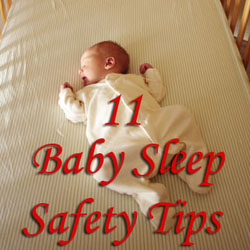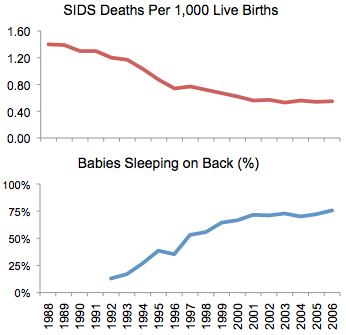what are recommendations of the back to sleep campaign

Sleep Rubber Guidelines
In late 2011, the American Academy of Pediatrics (AAP) released updated guidelines for promoting safe slumber for babies. These are recommendations made by pediatricians to reduce the adventure of SIDS. Though their list is extensive (and backed up with a lot of enquiry), I've boiled it downward to the essential baby sleep rubber tips.

Upshot of the Dorsum To Sleep Campaign
Put your babe on his or her back to sleep every time
Infants should be placed in a "supine" position — completely on their backs — to sleep. This should be washed every time the baby goes to bed (including naps) and continued until 1 twelvemonth of age.
Some parents worry that doing so increases the risk of choking, but this is non the case. Babies have protective airway mechanisms to foreclose this. Fifty-fifty with babies that have reflux should exist put on their backs to sleep.
Apply a firm [apartment] sleep surface
Ideally, a house mattress covered by a fitted sheet. The AAP recommends that a crib befitting to ASTM safety standards be used. Check to make certain that your crib or mattress hasn't been recalled. The mattress should exist sized to fit your baby's crib (see our list of the best baby crib mattresses). Importantly, don't put your baby in a crib with missing parts, and don't effort to set up a broken crib yourself.
Also, make sure the crib or bassinet is placed in a safe location, abroad from electrical cords, mini-blind cords, etc. (run into our article on 5 dangers near your baby's crib). Sitting devices, such as automobile seats, strollers, and swings, are not recommended for routine sleep. This is especially important for babies younger than iv months of historic period, as partially-upright positions might cause their airway to become obstructed.
Sleep in the aforementioned room, but not the same bed, as your babe
Under no circumstances should your infant sleep in bed with you. Doing so exploses them to lots of suffocation and strangulation hazards, including pillows, loose blankets, sheets, and the bodies of the parents. This is a real danger. Also, it's recommended that the mini crib or bassinet be put in the parents' room near their bed so that they can monitor and condolement the baby overnight. There are at present infant monitors that find sound and motion to help you monitor your infant when you're out of the room.
Proceed soft objects and loose bedding out of the crib
Your baby's bed should have iii things in information technology: a mattress, a fitted sheet, and the infant. No pillows, no soft cushy toys, no sheepskins, no loose bedding of whatsoever kind. It'south OK to swaddle or put him in a baby slumber sack, only loose blankets are not recommended. Crib bumpers and bumper pads should non exist used. These increment the risk of suffocation, entrapment, and strangulation. Don't worry that your infant will injure himself on the confined of the crib – he won't. Throw those bumpers away.
Offer a pacifier at nap time and bedtimeThough the mechanism is unclear, the use of a pacifier is associated with reduced risk of SIDS. My personal proposition is to go along two or three of your all-time babe pacifiers in the crib and then that y'all tin can discover one when you demand it, even in the dark. The AAP says that you should put it in when you put the baby to bed, only y'all don't need to re-insert it if the pacifier falls out while your baby is asleep; the protective effect continues even if the pacifier isn't in the infant's mouth. For breastfed babies, the pacifier should not be introduced until 3-4 weeks of age to avert nipple confusion. | Soothie Babe Pacifier |
Avoid Overheating the Baby
Your infant should be dressed appropriately for the environment, with no more than one layer of wear on than an adult would wear comfortably. Check your babe for signs of overheating — perspiration or feeling hot to the bear on — and accost them immediately, even if the infant's asleep. Meet as well our guide to what a newborn should sleep in.
Breastfeed your babyThe AAP recommends that y'all breastfeed your infant, feeding just breast milk (direct or expressed) until half dozen months of historic period. There is a protective upshot against SIDS for breastfed babies. Exclusive breastfeeding is all-time, but some breastfeeding is improve than none at all. If y'all're having problem, consider a quality breast pump so that you can store and feed expressed milk. | Medela Breast Pump |
Do not use home breathing/heart charge per unit monitors
This ane surprised me. The AAP recommends confronting using dwelling house cardiorespiratory monitors, the kind that detect apnea (pauses in animate while sleeping), brachycardia (heart rate drops) and/or blood hemoglobin oxygenation. There is no bear witness that these subtract the incidence of SIDS. While there may be some values for certain infants (preemies?), monitors should non be used routinely.
I did non see whatever specific recommendations against using a baby movement monitor similar the Snuza Halo. Run across our review article for some good options.
Yous may accept seen baby slumber positioners, crib ramps, or other products claiming to reduce the take a chance of SIDS. The AAP found no evidence that these were effective and recommends against them. For more, meet my post on the myth of infant sleep positioners.
Pregnant women should receive regular prenatal care
Co-ordinate to the AAP, there is "substantial bear witness" that women who have prenatal intendance are less probable to take a infant that dies from SIDS.
Avoid smoke exposure during pregnancy and after birth
Smoking should absolutely exist avoided by the mother, during pregnancy and after birth. Too, you should minimize your babe'due south exposure to smoke from other people, including relatives and friends. Fume lingers in pilus and vesture; people who smoke should generally non be about (and certainly not holding) your babe. Also, smoking combined with co-sleeping creates a high take a chance for SIDS.
It's but selfish to smoke around a baby.
Avoid alcohol and illicit drug use during pregnancy and later on birth
Alcohol taken during pregnancy endangers a fetus. Yous should know this already. After nativity, alcohol should be avoided because it impairs your judgment and dexterity, which could prevent you from caring for your baby. Alcohol and/or drug use in combination with co-sleeping creates a particularly loftier take chances for SIDS.
My question to the AAP: shouldn't illicit drug use be avoided at ALL times?
What To Read Side by side
Source: http://get-your-baby-to-sleep.com/back-to-sleep-safety-guidelines/
0 Response to "what are recommendations of the back to sleep campaign"
إرسال تعليق